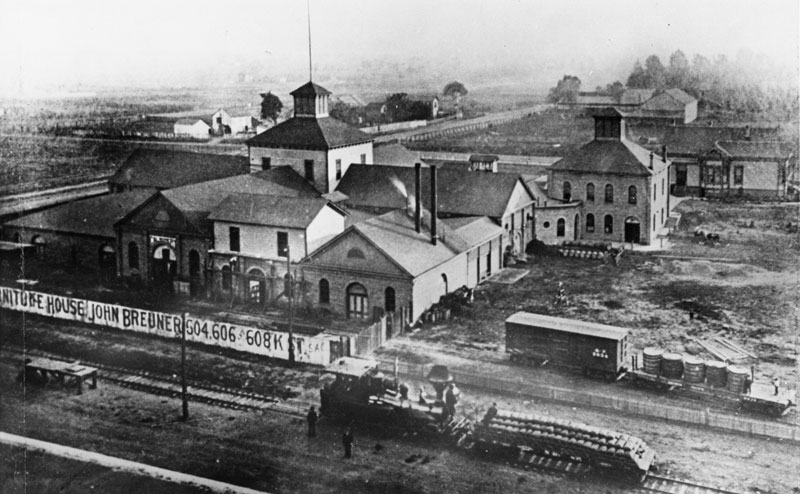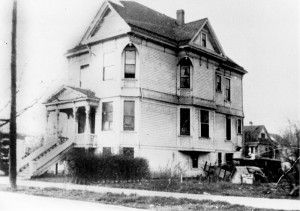Sacramento’s Urban Wineries
Posted on November 3, 2011 – 11:22 PM | by AdminBy William Burg
Sacramento’s urban wineries reflected our city’s ethnic diversity, transportation network, and a close relationship with nearby vineyards. Unlike the brewing industry, dominated by German families, Sacramento’s wine industry was multicultural, including German, Portuguese, Italian and Irish families.
Sacramento’s first winery was Jacob Knauth’s “Sutter Hall” at 29th and J, established in 1851. Knauth imported German grape cuttings from the Rhine, establishing a 20 acre vineyard in East Sacramento in 1854 and later the 640 acre Orleans Hill vineyard in Yolo County. Sutter Hall was damaged in the flood of December 1861, and destroyed in the even bigger floods of January 1862 that collapsed the walls of Knauth’s wine cellar. Knauth later opened a wholesale wine and brandy shop at 811 J Street.
In 1871, San Francisco wine merchants Samuel Lachman and Adolph Eberhardt, Jewish immigrants from Germany, built a winery at 21st and R Street. Eberhardt left the partnership in 1872, but Lachman expanded the facility in 1874 to a storage capacity of almost 500,000 gallons.

Across the tracks from the Buffalo Brewery at 21st and R, the California Winery operated between 1871 and 1920.
The winery was sold to Portuguese immigrant Manuel Nevis in 1888, who renamed it the California Winery. Nevis already owned two other wineries, the Eagle Winery at 1517 18th (founded in 1881) and the Pioneer Winery on the western side of 21st and R Street. In 1889 Nevis sold the Eagle to business partner Manuel Azevedo, and lost the California Winery during the depression of 1894. On September 24, 1907, Nevis fell off a ladder into a wine vat at Pioneer Winery while trying to change a light bulb. The vat was nearly empty, but either the fumes or the fall were enough to overcome him, and the master winemaker died in a vat of his own wine. The Pioneer operated briefly as the Paul Samuel Winery, but by 1910 it was again called the Pioneer Winery, run by Manuel’s widow Emma.

Master winemaker Manuel Nevis’ home still stands at 1822 21st Street. (Photo Credit: Portuguese Historical & Cultural Society)
California Winery was taken over by California State Bank in 1894, and Utah-born banker Frederick Kiesel and bank vice-president George Peltier purchased the foreclosed winery. They reopened as the Calutha Winery, merchandising the wines under the name “Kieselberger.” In 1903-1904, Kiesel and Peltier established the 300 acre Cordova Vineyard, re-establishing their brand as “The California Winery” and marketing their product as “Cordova, the Wine of Quality,” endorsed by President Theodore Roosevelt on a 1905 trip to Sacramento. This rebranding may have been the work of Sacramento-born Edgar Sheehan, hired in 1904 as head of publicity and promoted to Preisdent by 1910.
Italian immigrants Adriano and Severino Mazzini opened a grocery and wine shop at 306 L Street in 1881, and in 1887 founded the Mazzini Winery at 1110 Third Street, with a retail office, Baccus Wine Cellars, around the corner at 228 K Street. In 1911, Edgar Sheehan (formerly of California Winery) reopened Manuel Nevis’ Pioneer Winery as the Sacramento Valley Winery. Italian winemaker Vittorio Colombiani produced “Vestal Vintages” wines there until 1918. Another Italian winery, Roma Winery, opened at 15th and T in 1910, established by Alfredo Simi. At its peak, Roma produced 80,000 gallons of wine and 6,000 gallons of brandy per year.
Outside of Sacramento, the town of Florin was established as a viticulture experiment by E.B. Crocker and horticulturist James Rutter, the first person to plant Tokay grapes in California. In 1897, James Frasinetti planted a vineyard in Florin, now site of Tokay Park, later expanding to 480 acres and establishing the Frasinetti Winery. Prohibition closed most vineyards and wineries, but some survived by producing limited amounts of wine for sacramental or medicinal use (allowed by doctor’s prescription) or producing grape juice or syrup (often with labels warning that improper storage could lead to illegal fermentation.) Frasinetti sold his grapes for table use and produced “altar wine” for churches, and converted part of his acreage to other crops. By the 1930s Florin became better known for strawberry production, farmed by a growing Japanese American population. Today, Frasinetti is the oldest winery in the Sacramento area, but none of Sacramento’s city wineries survived Prohibition, and the Frasinetti winery, once a rural farm area, is today an urban winery, producing wines from grapes grown outside Sacramento.



6 Responses to “Sacramento’s Urban Wineries”
By Joe Genshlea on Nov 7, 2011 | Reply
Much thanks to the author for writing this article. Ed Sheehan mentioned in the article, was actually my Great, Great, Great uncle or something. While Frasinetti is the oldest winery in the Sacramento area, Revolution Wines is the only winery in Sacramento’s urban area that produces wine from locally grown grapes. The tasting room is open from 12-9 Tues day through Sunday. Wines are great too!
By Alan O'Connor on Dec 1, 2011 | Reply
Hi Bill-
I really enjoyed Sacramento’s Urban Wineries. Thanks for all you contribute to local history!
I’ve very interesting in finding out more about the Cordova Vineyard from 1903-10. Do you have more info, photos or artifacts? Please get back to me on this thru email.
Thanks-
Alan
By Eic on May 14, 2012 | Reply
Alan,
I was going to put the documents I have from California Wineries, but it looks like You need them and they are important to You. If You are interested feel free to get ahold of Me.
Thank You
By Rancho Cordoav History on Sep 7, 2012 | Reply
Do you have any information about Cordova Vineyards being owned by Roland Federspiel in Rancho Cordova? When he acquired the Vineyard? Was there 300 acres acquired? How did he come by this property and where is it located?
By Donna Mendelsohn on Oct 2, 2012 | Reply
Hello William:
Henry Michalski and I have recently written Napa Valley’s Jewish Heritage which was published by Arcadia Publishing in July 30,2012. A segment included the Lachman and Jacobi winery as well as Henry Lachman.
We knew that both Lachman and Jacobi were Jewish but were unaware that Adolph Eberhardt was also Jewish. Is there any way you could provide us with the geneological information regarding this?
Many thanks –
Donna Mendelsohn, Napa – co -chair Jewish Historical Society of Napa Valley
By steve abbott on May 8, 2015 | Reply
Bill,
Where were the 300 acres of Cordova Vineyard? Inclusive years? Distillery for brandy? Brands? Steve Abbott